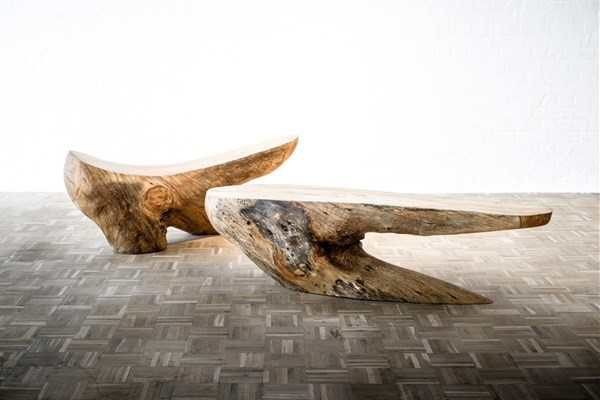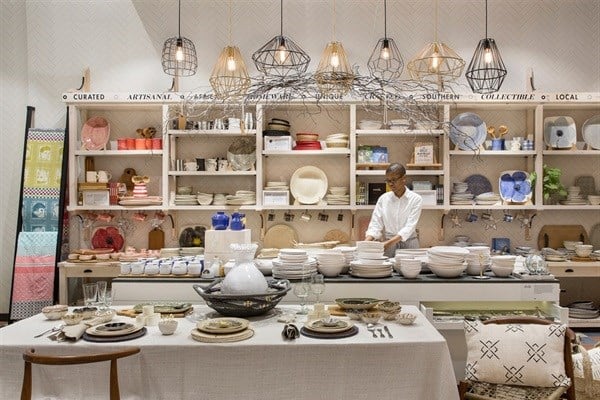#DesignMonth: Discussing Cape Town's design edginess with The Guild Group
Tracy Lynn Chemaly, head of programme for conference programme Business of Design, and brand and communications director for The Guild Group, and The Guild Group’s creative director Tammy Tinker welcomed me to the soon-to-be-moved space by pointing out pieces in the current Transformation exhibition (on until 3 March) just asking to be stopped and stared at: Guy du Toit’s 315 tiny bronze chairs (Stoele) mounted into an eye-catching display on the wall; David Krynauw’s Jeppestown Play Bench – a massive seating environment that turns like a wheel; Adam Birch’s wooden benches made from Eucalyptus trees that he brings to life again in furniture form; and Justine Mahoney’s collages and corresponding sculptures sitting in the back gallery space, featuring icons from her childhood and current pop culture (hello, Powerpuff Girls), all in the impressively high-ceilinged, white-walled space that exudes an air of calmness in the bustle of hip industria.
It was the ideal setting for Chemaly to explain that design definitely has a place in business across any industry, but especially in the creative industries. It’s a fact that design has played such an integral role in business development in the past few years, with a growing understanding of the importance of design thinking and as a result employing design-led thinkers across the board, who are as important as the financial and marketing director.
Design-thinking for any business
“Design thinkers put a spin on the way you plan and implement your systems and your processes, the way you even welcome or attract clients,” says Chemaly. It’s a different approach to traditional creative marketing thinking – it’s about actually putting a design element into your systems. She says they’ve seen a lot of that with Business of Design and the people serving as consultants to help run businesses and steer them in a new direction. “Especially with so much content going online, there’s a lot that needs to be considered when creating new platforms or ways of communicating, so it is very much design-led now,” concludes Chemaly.
That said, many of Business of Design’s speakers are of the older, purely physical design set but that doesn’t mean they’re not design thinkers. Explaining the movement’s origins, Chemaly says it’s coming from a more informed audience rather than being based on the ‘millennial way of thinking’. She explains that people just have so much more information at hand that it’s coming from a competitive environment with so much to choose from. We’re moving towards designing according to the audience based on an over-saturation of information that’s gearing people towards having to design for niche markets.
Narrowing the scope specifically to what they do in The Guild Group and what the overall brand encapsulates, first up is Business of Design, which is run in collaboration with Platform Creative Agency’s Cathy O’Clery and Laurence Brick, a conference that has become one of my personal favourite out-of-office events.
The Guild Group is a holding group, with many brands related to African design specifically falling under it. Founded by Julian and Trevyn McGowan as a way to share their passion for African design with the world, their website explains that Southern Guild in particular is the collectible design gallery, showcasing the best SA product designers producing limited edition, one-off pieces of which there have been over 500 in the gallery’s collection since Southern Guild was founded in 2008.

Chemaly adds that it serves as a platform to showcase and sell the best local design that’s exhibited in its two galleries in Cape Town and Johannesburg, where people can view the work and purchase it for their homes. Southern Guild then takes these designs internationally to leading design fairs across the globe, such as Design Miami and Design Days Dubai. It’s a collection that strives to progress, stimulate and promote the industry. Then there’s Source, which is the export agency leg responsible for over 70% of SA’s product design exports, acting as agents between the southern African designers, covering everything from glassware and ceramics to basket ware, bowls and beading, facilitating the export to retailers such as The Conran Shop, Anthropologie and Heal’s across the world who are now accessing African design through Source. As an offshoot of that The Guild Group has created its own homeware store called Odeon, in the V&A Waterfront’s Watershed as well as in the Mall of Africa. It sells a curated selection of top southern African homeware, kitchen, bedroom, living room and bathroom items that give a true feel of work produced in this country – a rarity with so many stores selling produce made elsewhere. This really is a one-stop shop for supporting local artisanal work. There’s also the Woodstock Design District Map, which is annually updated to feature this hub of design-driven business in the Woodstock area.
More than this, Chemaly explains that through the non-profit Design Foundation, top and up-and-coming designers are awarded annually. The Foundation itself is an independent body that’s run by a board including people from the media, finance, legal and other sectors to support and award talent in the country, with no other platform doing so in this way, and The Guild Group facilitates the process. For example, the apprentice award goes to a recent graduate who is placed within the design company sponsoring the award that year. They therefore gain valuable experience within a factory or studio space, with one of SA’s leading design companies or designers. Then there’s the future found foundation award, where an existing business needs a kick start – either monetary or through opportunity to exhibit at a show like 100% Design South Africa, so more people are exposed to what the designer is doing. The design with purpose award then shows that design doesn’t need to be a product necessarily, with various nominees in different fields this last year, for example an app designer that solved a social issue, or people who designed a product to help with veld fires. The one that won? Thato Kgatlhanye’s ‘repurpose schoolbags’, made from recycled items that includes a light inside, so children without electricity in their homes can do their homework. It’s about showcasing and awarding the variety of design out there. The Foundation is currently looking for funding and is a non-profit, without any income. The Guild Group gives of its time where it can, but the initiative definitely needs financial support from business to keep it going.
1,000 ways to show you love Cape Town
Shifting focus to future plans, Guild Silo is the next big thing, a new, permanent space Guild will have at the Waterfront Silo District from May 2017. The whole district will be focused on art and design – next door to Guild’s space will be Kirsten Goss Jewellery, Kat van Duinen, Opus and a cool new eatery, making it an attractive destination.
This space will allow Guild to present work either by Southern Guild designers in the gallery space that’s moving there from Woodstock, with the first show set to feature Southern Guild’s design heroes, showcasing the top designers they’ve worked with over the past nine years and telling their stories, with future shows including international collaborations. There’ll also be a studio space to showcase and sell design furniture produced in-house by the Guild team – high-quality, timeless classics. Most excitingly, the space will also house the Guild concept store, something not done in SA before. This means 10 well-known designers, from product to photography to animation to fashion – think the likes of Andile Dyalvane, Atang Tshikare and Porky Hefer – will create a design that will be printed onto a variety of products. So they will each design a picture, which will be printed onto fabric and made into a bag, put onto a mug, and wrapped around pencils. Each designer’s design will be put onto various products, and they’ll also create individual ‘I love Cape Town’ t-shirts different to the standard design we’ve seen before. Instead, they’re taking what they love about Cape Town – their interpretation – and their t-shirts will feature that. These will be limited edition.
That’s fitting as Cape Town is leading the country’s design-thinking trends. Chemaly says the city’s 2014 WDC title certainly played a part, but Cape Town has always had that image and while it may feature in other cities too, you just don’t see it in quite the same nucleus form. “Because of districts like Woodstock and streets like Bree Street, where you get to see so much within a small space, you see it as heightened here over Johannesburg, for example, where it’s much more spread out.” Cape Town has definitely received a lot more design-driven publicity as a result of WDC’s international visitors and media during that year, putting it more on the map. “We’re also lucky because we’ve got so much design inspiration all around us,” Chemaly says.
That there is. Click here for more on how The Guild Group is doing extraordinary things in support of local design and be sure to follow them on Pinterest, Facebook and Instagram for more.


















